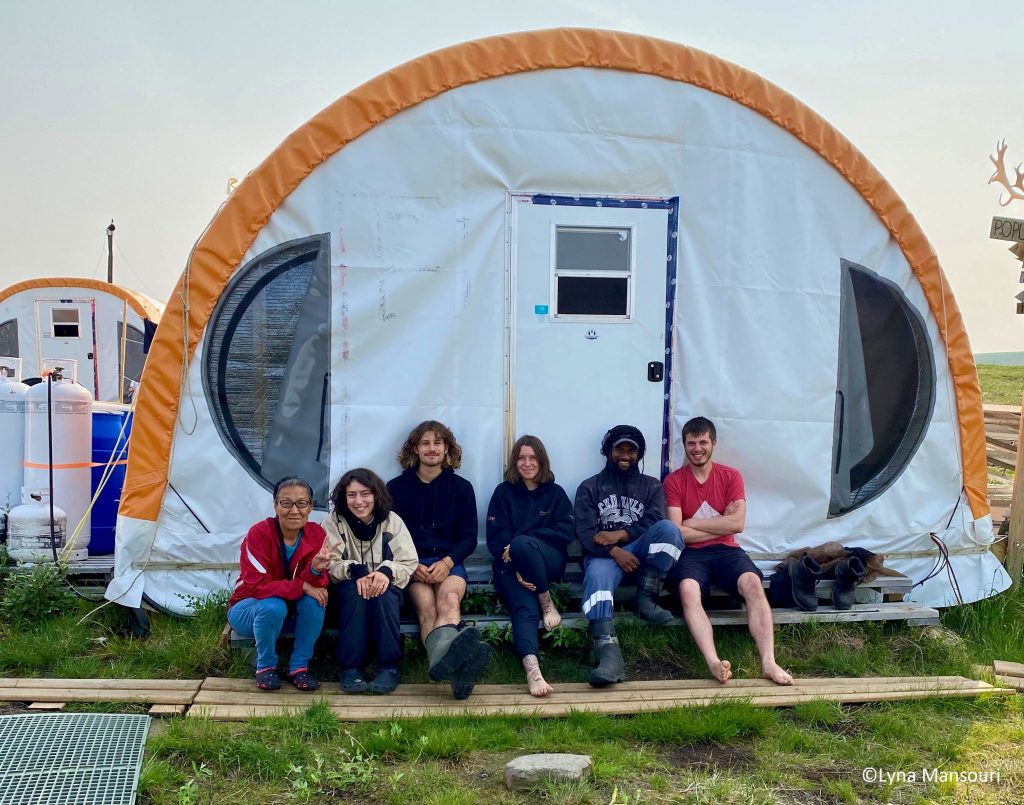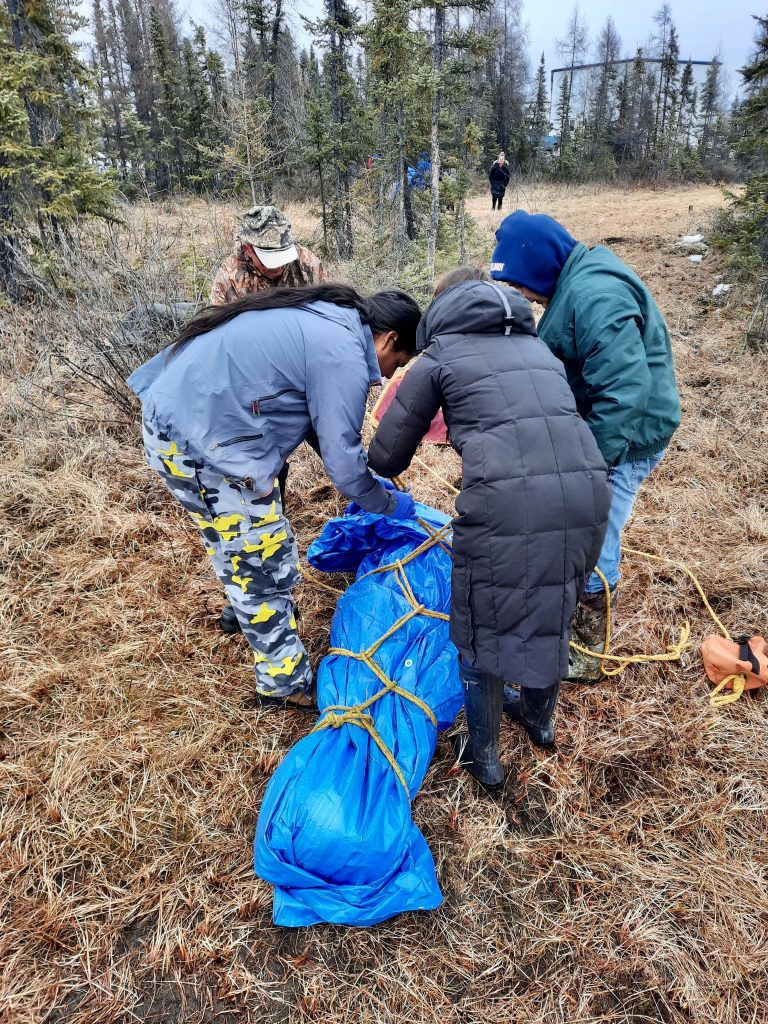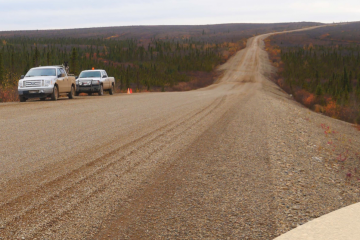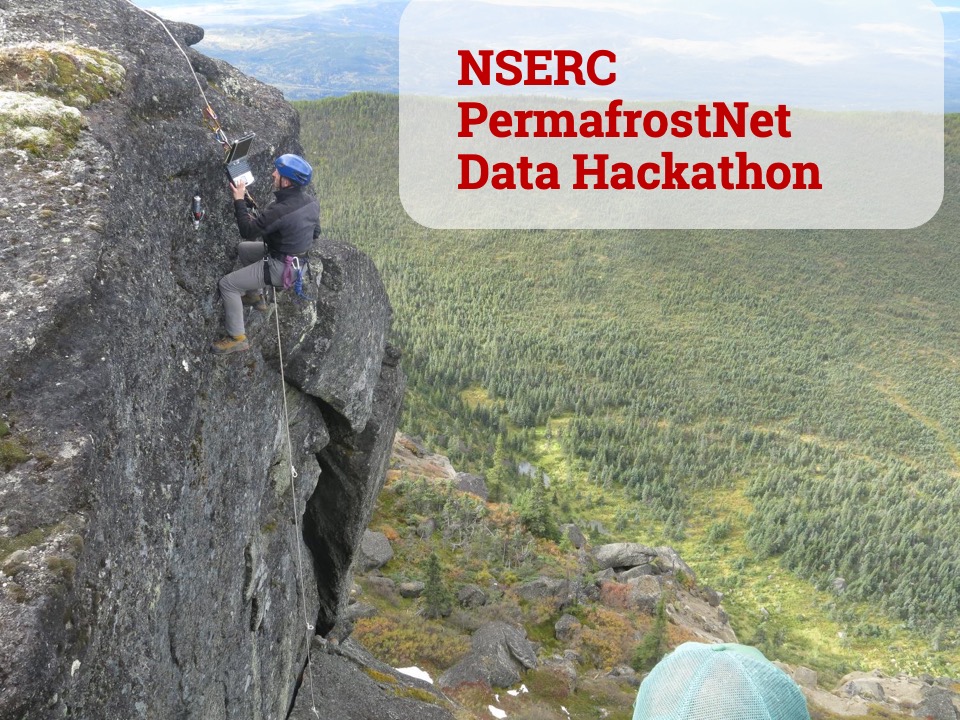Trail Valley Creek Research Station by Charles Gauthier
In early June, I had the chance to be part of a team of scientists heading to the Trail Valley Creek Research Station. Located a 30-minute helicopter ride away from Inuvik, NT, Trail Valley Creek supports many different long-term projects. My colleague, Vincent Graveline, and I were there for two weeks during which our goal was to launch weather balloons as part of Vincent’s MSc research on planetary boundary layer dynamics. Attached to the balloons were detachable probes equipped with several instruments reading pressure, altitude and, most importantly, air temperature. Our goal was to observe the height of the planetary boundary layer in spring. The depth of the planetary boundary layer affects the land-atmosphere interactions, and its depth varies depending on land cover and atmospheric conditions. With the boreal tree line shifting northward, information on the planetary boundary layer over the tundra and a nearby forest stand will help to better understand the consequences of boreal treeline shifts on tundra-atmosphere interactions.
A typical day could be split in three parts: the launch of the balloon, the wait for it to climb to a specific, pre-determined altitude and the retrieval of the probe. We walked over 70 km in the tundra, a radio receiver in hand looking for the white probe the size of a styrofoam cup with a single flashing LED light. This research trip allowed me to visit a changing arctic tundra research site where permafrost is rapidly thawing, a sight that I don’t normally see while modeling permafrost change from the comfort of campus. Science aside, the landscapes, the berries and the sneaky ptarmigans were worth all the soreness in our legs!
Field work report by Charles Gauthier.
Scotty Creek Research Station by Rose Lefebvre
In August, I went to the Scotty Creek research station in the Northwest Territories. As a modeler, being able to go to the field was a great opportunity: it allowed me to better understand one of the sites I am trying to model.
The goal of my project is to simulate the climatic conditions of higher latitude regions, often underlain by permafrost, in a more accurate way. To achieve this, I will be including mosses in CLASSIC, the Canadian Land Surface Scheme Including Biogeochemical Cycles, as a plant functional type. Seeing Scotty Creek improved my understanding of just how much mosses are important in northern regions.
I was in Scotty Creek to help with a drone data collection project: I climbed an eddy covariance tower to ensure there was always someone who could see the drone, while the drone pilot was back in camp. This allowed me to see the drone above the trees.
I also took active layer depth measurements around the eddy covariance tower. This allows us to monitor permafrost thawing, which happens rapidly at Scotty Creek. We can see the impact it has on trees at the limit between the forested permafrost plateaus and the permafrost free bogs: they start to tilt from the instability of the ground.
Field work report by Rose Lefebvre.

Engaging the Inuvik community by Lyna Mansouri
For several scientists and students, the highlight of research is fieldwork. Sometimes, to produce high-quality data in permafrost-related research, the study sites can be isolated. Now, they are not only remote because they are north (from a southerner’s perspective), but rather because they are secluded from the communities. For instance, the Trail Valley Creek (TVC) research station is situated north of Inuvik, NWT, in the middle of the tundra. As field season is extremely busy and dense, the researchers rarely have time to exchange and connect with local communities. They live and work out of the research station for most of the time they spend in the region. This poses the issue of creating a gap between researchers and community members. Indeed, it feels counterintuitive since research’s primary goal is to inform decision-making and produce tools to build resilience for local communities.
In the past year, thanks to funding from Future Skills Center, NSERC PermafrostNet, IVADO and other sources, the situation is in remediation. During our fieldwork in TVC, my colleagues and I had the opportunity to work with several members of the community. One of our colleagues, Camellia, planned a marvellous barbecue with family and friends from Inuvik and, at last, scientists were stepping out of the research station and into building relationships with folks from the community. These kinds of activities and partnerships at the sites are concrete steps towards crafting research projects for, and with, the community and ultimately bridging the gap between scientists, students, and community members.

Finalizing a “nested” Arctic tundra flux set-up by Oliver Sonnentag
After several years of planning, and delayed by the Covid-19 pandemic, the Sonnentag lab completed a “nested” Arctic tundra flux set-up (landscape > ecosystem > plot) at Trail Valley Creek Research Station near Inuvik, NT. The flux set-up comprises three eddy covariance (EC) towers, and automated and manual chamber systems. The 20-m landscape EC tower measures net carbon dioxide, methane, and latent and sensible heat exchanges between the terrestrial-aquatic landscape (including extensive shrub patches) and the atmosphere. Given prevailing wind characteristics, nested within the landscape flux footprint (i.e., the temporally varying source area) are a 5-m and a 7-m ecosystem EC towers, one “seeing” fluxes originating from polygonal tundra, or, depending on wind direction, a small lake, and one “seeing” fluxes originating from mineral upland tundra, respectively. Nested within the ecosystem flux footprint (mineral upland tundra) is a custom-made chamber system to measure plot-scale net carbon dioxide and methane exchanges. The system comprises 18 automated chambers (nine ‘transparent’ and nine ‘opaque’ chambers), each with three replicates for three distinct plant communities: dwarf shrub, tussock, and lichen cover. Manual chamber measurements are collected from additional plant communities and land cover types (e.g., polygonal tundra and lakes). The chamber measurements are complemented by ancillary measurements of air and soil temperature, photosynthetic photon flux density, active layer depth, plant community composition, spectral characteristics, greenness, and soil moisture, temperature, and oxygen. Additional measurements to understand the underlying biogeochemical processes governing the carbon dioxide and methane sink-source behaviour: soil physical-chemical properties and gas profile dynamics, isotopic signal of d13C in soil carbon dioxide and methane, soil pore water and lake nutrient concentrations, quality and microbial degradability of aquatic dissolved organic matter and microbial community composition. The goal of these comprehensive observations is to shed light on how tall shrub encroachment affects vegetation diversity and associated surface-atmosphere interactions across scales in the Southern Arctic ecozone of western Canada.

Community training workshops in the NWT: Yellowknife (2 – 13 May) and Inuvik (6 – 9 September) by Oliver Sonnentag
The Sonnentag lab hosted two community training workshops this summer. With 15 (Yellowknife) and 10 participants (Inuvik), both workshops were well attended. Primarily funded through the Future Skills Centre, the first week of the workshop in Yellowknife included safety certifications for wilderness first aid, fall protection and wildlife awareness. The second week focused on hands-on training in micrometeorological instrumentation and scientific instrumentation maintenance, used in combination with traditional experiences and perspectives.
Presentations, practical sessions and discussions were led by industry, academic, territorial government non-governmental organizations and Indigenous government representatives. The workshop in Inuvik was hosted through Sonnntag’s involvement in an IVADO-funded project on artificial intelligence, biodiversity and climate change. Presented by ASPECT-drone solutions, the focus of the workshop was on preparing participants for the Small Advanced Exam required by Transport Canada for advanced drone operation.


























